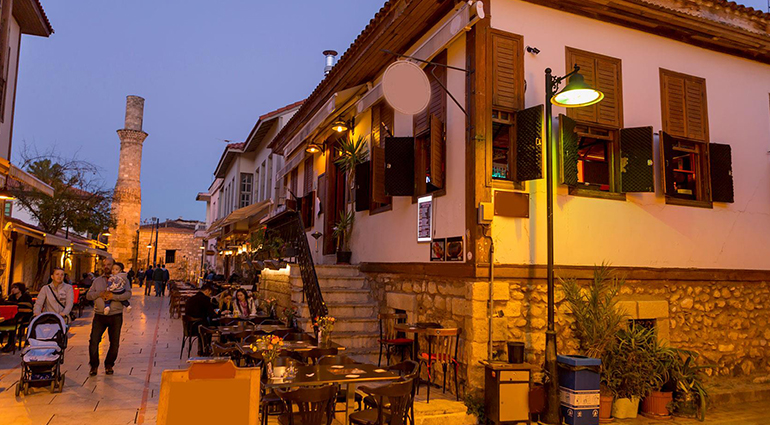The houses of Kaleiçi that have survived to the present day are buildings that were constructed in the second half of 19th and early in the 20th century, together with a few apartments blocks built in the 1970’s. The houses are generally of a size to enable large families comprising several generations to live together, are today partially utilized for personal housing, partially for cultural and commercial purposes. The houses, some of which were abandoned by their owners and left to collapse until recently due to the high cost of repairs, have begun to be restored in recent years through the development of commercial and cultural life in Kaleiçi.
All the houses were designed as two-storied and the ground-floor walls were built from wooden frame and rubble stone for seismic reasons and the upstairs were, in the same material and the same technique in some houses as in the downstairs, in other houses the upstairs were built in timbre frame technique with lath and plaster. The surfaces of the walls were white-washed or plastered.
The entrance to the houses, all of which have a street facade is generally provided by a huge door with two leaves. These doors rarely opened directly on a garden; because many of the houses were built in row housing, there is generally a semi-enclosed space called as taşlık immediately after the entrance and in this type of house the gardens are not directly connected to the street. The Taşlık which offers a comfortable life and resting area especially in the temperate and hot climate was an indispensible element of every house in Kaleiçi. It takes its name from the pebble mosaics set in to form the floor, in which there are generally floral and geometrical decorations, rarely is it decorated with figures of people. The taşlıkis opened to the courtyard from one direction. Although there were channels, pipes and closed water canals before the modern water supply network, there is always a rain-fed cistern within each courtyard. The rooms around the taşlıkin housesthat are generally taller than a single storey were employed for storage and as serving rooms, rather than providing private living space in the downstairs. The first floor accessed via a wooden staircase from the taşlık provides the main and the private living spaces of the house. From the top of the wooden stairs one directly reaches the half-open space termed the patio or sofa. This space that opened sometimes to only the courtyard and sometimes out to the street with its Windows, was employed as an area for meeting together and the common living area. From this area doors open to all the rooms. Each house has a large main room, often with elaborate shelving-cupboards, where the guests are accommodated. There is a section for sherbet within the niche in the room in which there are divans along the walls. The wooden floor is covered with carpets or rugs. It has an elaborately decorated wooden ceiling. Other rooms form the private living spaces of the house. There are shutters and covings and abundant windows forming a bow window on the facades facing the street. The covings and shutters add dynamism and richness with their forms and designs to facades and streets, as well as providing volumetric contribution to the house. Sometimes ashlar stonework can also be seen on facades that are coated or plastered. In addition to being constructed from wood, the door and window frames exhibit cut stone frames, profiled workmanship, particularly in those houses decorated in the Neo-classical style. In addition to plaster relief-work, hand-carved waterleaves, moon and star, flowers and scenes, corners with fluted plasters and Corinthian capitals, consoles of bow window with meander and acanthus motifs can still be found beneath the roof and beneath bow windows on these facades. In some houses there are also decorations depicting the lion, eagle and angel as well as expressions in calligraphy, such as: “God” (Allah) and “Praise be!” (Maşallah) with Arabic letters on some houses. At the corners of the houses chamfered Stones (glazes) termed “awry” (çalık) can be seen. These served the function of preventing damage to the corner of the building from the passing horse-drawn vehicles in these narrow streets without a pavement. These corners chamfered at a 45-degree angle and up to 2 m height on average, can carry floral decoration, basic muqarnas, the başmala or an amulet on their upper parts which usually take the form of a pointed.
In addition to the vast residences, there exist evidence for the former presence of a considerable amount of mansions constructed in Kaleiçi, clearly depicted in engravings of travellers who visited the city in the 19th century. Unfortunately few of these mansions with quite large courtyards have survived to the present day. Those that remain no longer serve their old functions and have been converted into touristic facilities after passing through restoration. Among these, the most significant example is the Tekelioğlu Mansions located on a high terrace formed by the fortification walls to the east of the port-Marina of today and the famous gardens mentioned by Evliya Çelebi in the 17th century. A facade in which there is a monumental arched stone door on Kocatepe Street remains today to indicate the approximate former location of a magnificent Greek mansion. It is understood that the Mansion of the Marbles (Mermerli Konak), constructed upon a high terrace in the southeast of the Marina once was one of the most famous mansions, among numerous examples. Today Mermerli Street, Mermerli Beach and Mermerli Restaurant in this locality still carry the name of this lost mansion.
